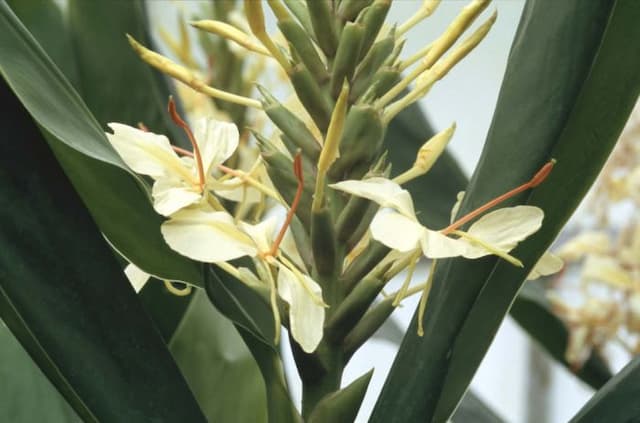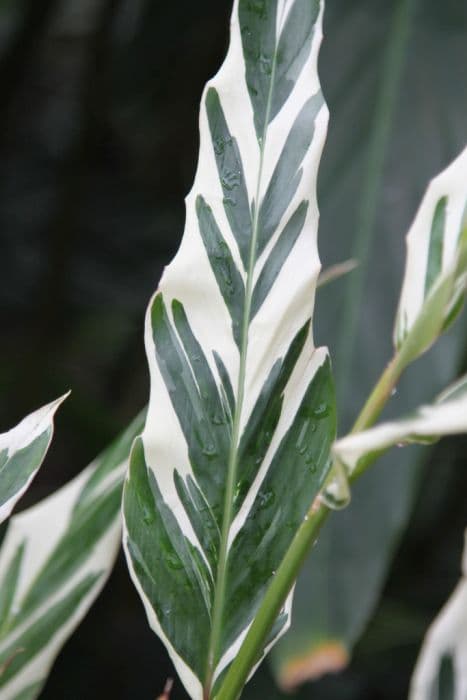Ginger wort Zingiber spectabile

ABOUT
The Beehive Ginger is a tropical plant known for its distinctive and ornamental bracts that resemble a beehive. The bracts are large, cone-shaped clusters that can vary in color, including shades of yellow, gold, and reddish-brown. These colorful bracts are what give this plant its common name, as they bear a striking resemblance to the structure of a beehive. The true flowers of the Beehive Ginger emerge from the bracts, but they are often small and less showy compared to the vibrant bracts. The leaves of the Beehive Ginger are also notable -- they are glossy, elongated, and lance-shaped, with a deep green color that provides a lush backdrop for the plant's more vivid structures. The foliage arranges itself in an alternating pattern along the lengths of the sturdy stems, contributing to the overall tropical appearance of the plant. Overall, the Beehive Ginger is prized for its unique and showy bracts, making it a popular addition to tropical gardens and floral arrangements. Its ornamental appearance is eye-catching, with the bracts often being the focal point that attracts attention and admiration.
About this plant
 Names
NamesFamily
Zingiberaceae
Synonyms
Beehive Ginger, Ginger Wort, Malaysian Ginger
Common names
Amomum spectabile, Zingiber spectabile var. rubromaculatum.
 Toxicity
ToxicityTo humans
Beehive ginger is not commonly known to be toxic to humans. However, as with any plant, individual reactions can vary, and it's generally advisable to avoid ingesting parts of ornamental plants due to potential unpredicted effects or allergic reactions.
To pets
Beehive ginger is not commonly listed as a toxic plant to pets. Nonetheless, it's always wise to prevent pets from ingesting plants, as they might cause gastrointestinal upset or an allergic reaction in some animals. If a pet ingests beehive ginger and shows signs of distress, it would be prudent to consult a veterinarian.
 Characteristics
CharacteristicsLife cycle
Perennials
Foliage type
Evergreen
Color of leaves
Green
Flower color
Yellow
Height
6 feet (1.8 meters)
Spread
3 feet (0.9 meters)
Plant type
Herb
Hardiness zones
10
Native area
Malaysia
Benefits
 General Benefits
General Benefits- Aesthetic Appeal: Zingiber spectabile, known as Beehive Ginger, is often used for ornamental purposes due to its unique inflorescence that resembles a beehive, adding an exotic and tropical flair to gardens and floral arrangements.
- Low Maintenance: Beehive Ginger plants are relatively low maintenance, once established they require minimal care, making them suitable for gardeners of all levels of experience.
- Attracts Wildlife: The flowers of the Beehive Ginger can attract pollinators like butterflies and bees to the garden, thus contributing to the local ecosystem.
- Drought Tolerant: Once established, Beehive Ginger can tolerate periods of drought, making it suitable for xeriscaping and a good choice for gardens in arid climates.
- Shade Loving: Beehive Ginger can thrive in partial shade, which makes it an ideal plant for incorporating into shaded areas of the garden where many other plants may struggle to grow.
- Cultural Significance: In certain cultures, the Beehive Ginger is used in traditional ceremonies and has symbolic meanings, adding cultural value beyond its ornamental use.
 Medical Properties
Medical Properties- Anti-inflammatory: Zingiber spectabile may contain compounds that have the potential to reduce inflammation, although clinical data is limited.
- Antioxidant: The rhizomes of the plant may have antioxidant properties, which can help in neutralizing harmful free radicals in the body.
- Antimicrobial: Some studies suggest that extracts from this plant might exhibit antimicrobial activity against certain pathogens.
 Air-purifying Qualities
Air-purifying QualitiesThis plant is not specifically known for air purifying qualities.
 Other Uses
Other Uses- Craft Material: The inflorescences of the Beehive Ginger can be used by craft enthusiasts to make unique and exotic decorations because of their unusual shape and longevity.
- Natural Dyes: The vibrant bracts of the plant may be used to extract natural dyes for textiles, offering eco-friendly coloring options.
- Floral Arrangements: Due to its visually intriguing shape and color, Beehive Ginger is often used in tropical floral arrangements and can last several weeks after being cut.
- Garden Ornamental: With its striking appearance, Beehive Ginger can be planted for ornamental purposes in tropical-themed gardens to add a touch of exotic flair.
- Photography Subject: The unique look of the Beehive Ginger makes it an excellent subject for botanical photography and plant enthusiasts who document unusual plant species.
- Botanical Studies: Beehive Ginger serves as an interesting specimen for botanical students or scholars studying plant morphology and adaptations.
- Educational Model: Educators may use Beehive Ginger to teach about pollination and the ways certain plants attract specific types of pollinators.
- Culinary Garnish: While not widely recognized for its taste, the flower of Beehive Ginger can occasionally be used as an edible garnish for culinary presentation in high-end cuisine.
- Theme Gardens: This plant can be included in educational theme gardens that aim to showcase a collection of ginger plant species and their distinct characteristics.
- Perfumery Inspiration: The Beehive Ginger can serve as an inspiration for perfumers looking to create new and exotic fragrances based on its subtle aroma.
Interesting Facts
 Feng Shui
Feng ShuiThe Beehive Ginger is not used in Feng Shui practice.
 Zodiac Sign Compitability
Zodiac Sign CompitabilityThe Beehive Ginger is not used in astrology practice.
 Plant Symbolism
Plant Symbolism- Exotic Beauty: Zingiber spectabile, commonly known as Beehive Ginger, is often associated with exotic beauty due to its unique beehive-shaped inflorescence and striking appearance.
- Rarity and Distinctiveness: Beehive Ginger is not a common plant and thus symbolizes rarity and the uniqueness of one's personality or style.
- Tropical Splendor: Since Beehive Ginger is native to Southeast Asia, it represents the lushness and vibrant life of tropical environments.
- Healing and Medicinal Properties: In traditional medicine, parts of the Beehive Ginger plant are used for healing, representing the plant's connection to health and recovery.
- Wealth and Prosperity: In some cultures, the Beehive Ginger is believed to attract wealth and prosperity, potentially due to its rich appearance and the value placed on exotic plants.
 Water
WaterThe Beehive Ginger, commonly known as Zingiber spectabile, should be watered deeply and allowed to partially dry out between waterings. On average, water once a week, but this may vary based on temperature and humidity. Provide roughly 1 gallon of water per watering session to ensure the soil is thoroughly moistened. During the growing season, the plant might require more frequent watering, especially if outdoors in warmer weather. In winter, reduce watering to every other week, ensuring the top inch of soil is dry to the touch before the next watering.
 Light
LightBeehive Ginger thrives in partial shade with some dappled sunlight. The ideal spot would be under a canopy of trees where it receives filtered light or in an area that gets morning sun and afternoon shade. Avoid placing it in direct, harsh sunlight as it can scorch the leaves and impact the plant’s growth.
 Temperature
TemperatureThe Beehive Ginger prefers warm and humid conditions, thriving between 65 and 85 degrees Fahrenheit. The minimum temperature should not drop below 50 degrees Fahrenheit to prevent cold damage. It's essential to protect this tropical plant from frost, which can be lethal or severely damage the foliage.
 Pruning
PruningPruning the Beehive Ginger is important to remove spent flower stalks and old leaves, encouraging healthy growth and better air circulation. Prune as needed, typically after blooming or when foliage appears damaged or diseased. The best time for pruning is in the late winter or early spring before new growth begins.
 Cleaning
CleaningAs needed
 Soil
SoilBeehive ginger plants thrive in a well-draining, rich organic mix with a slightly acidic to neutral pH of 6.0 to 7.0. A mixture of loamy soil, peat, and perlite or sand is ideal to ensure proper drainage and aeration.
 Repotting
RepottingBeehive gingers should be repotted every 2 to 3 years or when the rhizomes outgrow their container. Use a slightly larger pot to allow for growth.
 Humidity & Misting
Humidity & MistingBeehive ginger plants prefer high humidity conditions, generally around 60% or higher, to mimic their native tropical environment.
 Suitable locations
Suitable locationsIndoor
Place Beehive ginger in bright, indirect light and maintain high humidity.
Outdoor
Grow Beehive ginger in partial shade and humid conditions.
Hardiness zone
9-11 USDA
 Life cycle
Life cycleZingiber spectabile, commonly known as Beehive Ginger, begins its life as a rhizome, which is an underground stem that stores energy for the plant. Upon germination, the rhizome develops roots and shoots that emerge from the soil, initially producing lance-shaped green leaves. As the plant matures, pseudostems formed from the leaf bases grow upright, and the Beehive Ginger begins to form its distinctive inflorescence that resembles a beehive, with colors ranging from yellow to deep red. This unique flower arrangement is made up of many small flowers, and it serves as an attractant for pollinators such as bees and butterflies. After the flowering stage, the plant sets seeds, which can be dispersed to form new plants; however, Beehive Ginger more commonly propagates vegetatively through its rhizomes. As a tropical perennial, the plant may go through a period of dormancy in cooler months, with the above-ground foliage dying back, and then it will regrow the following season from the rhizome.
 Propogation
PropogationPropogation time
Spring to summer
Propogation: The Beehive Ginger, scientifically known as Zingiber spectabile, is commonly propagated through division, which is the most popular method. This typically involves separating the rhizomes, which are the horizontal underground stems capable of producing the root systems and shoots necessary for creating new plants. The ideal time for division is late winter or early spring before the growing season begins, when the plant is not actively growing. When dividing the rhizome, ensure that each section has at least one growth bud. These sections can then be planted in well-draining soil at a depth of approximately 1 to 2 inches (2.5 to 5 cm). It is crucial to keep the soil moist but not waterlogged to encourage root development. In 6 to 8 weeks, the rhizomes should begin to establish and eventually develop into mature Beehive Ginger plants.









